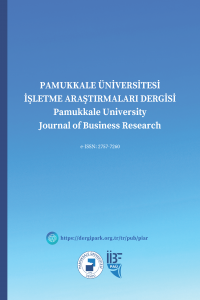Bölgesel Kalkınma ve İnovasyon Sarmal Modelleri İlişkisi: Türkiye Örneği (2010-2019)
Bölgesel Kalkınma, İnovasyon Sarmal Modelleri, Panel Veri Analizi
Relationship of Regional Development and Helix Models of Innovation: The Case of Turkey (2010-2019)
___
- Akpınar, R., Taşçı, K., & Özsan, M. E. (2011). Teoride ve Uygulamada Bölgesel Kalkınma Politikaları. R. Akpınar, K. Taşçı, & M. E. Özsan içinde, Teoride ve Uygulamada Bölgesel Kalkınma Politikaları (s. 21-22). Bursa: Ekin Kitabevi.
- Asheim, B., & Coenen, L. (2006). Contextualising Regional Innovation Systems in a Globalising Learning Economy: On Knowledge Bases and Institutional Frameworks. The Journal of Technology Transfer 31, 91.
- Carayannis, E., & Campbell, D. (2010). Triple Helix, Quadruple Helix and Quintuple Helix and how do knowledge, innovation and the environment relate to each other? A proposed framework for a trans-disciplinary analysis of sustainable development and social ecology. International Journal of Social Ecology and Sustainable Development, 41-69.
- Carayannis, E., & Campbell, D. (2012). Mode 3 knowledge production in quadruple helix innovation systems. 21st-century democracy, innovation, and entrepreneurship for development. New York: Springer. Çakırca, Ş. Y., Demirtaş, G., & Aksel, E. (2021). Türkiye’de Bölgesel Kalkınmanın Bir Belirleyicisi Olarak Uluslararası Göç Üzerine Ampirik Bir Analiz. İnsan ve Toplum Bilimleri Araştırmaları Dergisi.
- Etzkowitz, H. (2002). The Triple Helix of University-Industry–Government Implications for Policy and Evaluation. Stockholm. Galvao, A., Mascarenhas, C., & Marques, C. (2019). Triple Helix and its evolution: a systematic literature review. Journal of Science and Technology Policy Management, 812-833.
- Gujarati, D., & Porter, D. (2012). Basic Econometrics. India: McGraw-Hill Education. Güneş, S. (2016). Türkiye Ekonomisi ve Kalkınma Göstergeleri. S. Güneş içinde, Türkiye Ekonomisi ve Güncel Makroekonomik Konular (s. 468). Akademi.
- Pesaran, H. (2004). General Diagnostic Tests for Cross Section Dependence in Panels. Iza DP No. 1240. Todaro, M., & Smith, S. (2011). Economic Development ,11th Edition. Pearson Education and Addison-Wesley.
- Başlangıç: 2014
- Yayıncı: Pamukkale Üniversitesi
Türkiye'nin Vergi Yapısı: Edirne Değerlendirmesi
E-Ticaretin Vergilendirilmesi Sorunsalının Vergi Mevzuatı Açısından Analizi
MACBETH Tabanlı Bulanık MARCOS Yöntemi ile Bir Tekstil İşletmesi için Ürün Grubu Seçimi
Kur Korumalı Türk Lirası Mevduat Hesaplarının Muhasebeleştirilme Esasları
Kaan Ramazan ÇAKALI, Gürol BALOĞLU
Konut Seçimini Etkileyen Faktörlerin İncelenmesi: Balıkesir- Akçay Örneği
Proaktif Kişiliğin Yaşam Doyumuna Etkisinde Covid-19 Korkusunun Aracılık Rolü Üzerine Bir Araştırma
Kamil Abdullah EŞİDİR, Yunus Emre GÜR, Vahap YOĞUNLU, Muhammed ÇUBUK
Bölgesel Kalkınma ve İnovasyon Sarmal Modelleri İlişkisi: Türkiye Örneği (2010-2019)
Hırpalanmış Kadın Sendromu: Çalışan Kadınlar Açısından Bir İnceleme
